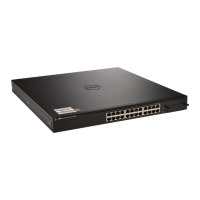144 Managing a Switch Stack
A single switch in the stack manages all the units in the stack (the stack
master), and you manage the stack by using a single IP address. The IP
address of the stack does not change, even if the stack master changes.
A stack is created by daisy-chaining stacking links on adjacent units. Up to
eight links per stack unit can be used for stacking (four in each direction). A
stack of units is manageable as a single entity when the units are connected
together. If a unit cannot detect a stacking partner on any port enabled for
stacking, the unit automatically operates as a standalone unit. If a stacking
partner is detected, the switch always operates in stacking mode. One unit in
the stack is designated as the stack master. The master manages all the units
in the stack. The stack master runs the user interface and switch software, and
propagates changes to the member units. To manage a stack using the serial
interface, you must connect to the serial port on the stack master. The serial
interface on member units does not allow access to the CLI.
A second switch is designated as the standby unit, which becomes the master
if the stack master is unavailable. You can manually configure which unit is
selected as the standby, or the system can select the standby automatically.
When units are in a stack, the following activities occur:
• All units are checked for software version consistency.
• The switch Control Plane is active only on the master. The Control Plane
is a software layer that manages system and hardware configuration and
runs the network control protocols to set system configuration and state.
• The switch Data Plane is active on all units in the stack, including the
master. The Data Plane is the set of hardware components that forward
data packets without intervention from a control CPU.
• The running configuration is propagated to all units and the application
state is synchronized between the master and standby during normal
stacking operation. The startup configuration and backup configuration
on the stack members are not overwritten with the master switch
configuration.
Dell strongly recommends connecting the stack in a ring topology so that
each switch is connected to two other switches.

